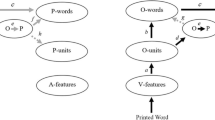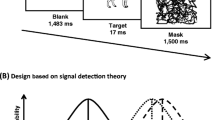Abstract
Although it has been established that human beings process concrete and abstract words differently, it is still a matter of debate what factors contribute to this difference. Since concrete concepts are closely tied to sensory perception, perceptual experience seems to play an important role in their processing. The present study investigated the processing of nouns during an auditory lexical decision task. Participants came from three populations differing in their visual-perceptual experience: congenitally blind persons, word-color synesthetes, and sighted non-synesthetes. Specifically, three features with potential relevance to concreteness were manipulated: sensory perception, emotionality, and Husserlian lifeworld, a concept related to the inner versus the outer world of the self. In addition to a classical concreteness effect, our results revealed a significant effect of lifeworld: words that are closely linked to the internal states of humans were processed faster than words referring to the outside world. When lifeworld was introduced as predictor, there was no effect of emotionality. Concerning participants’ perceptual experience, an interaction between participant group and item characteristics was found: the effects of both concreteness and lifeworld were more pronounced for blind compared to sighted participants. We will discuss the results in the context of embodied semantics, and we will propose an approach to concreteness based on the individual’s bodily experience and the relatedness of a given concept to the self.


Similar content being viewed by others
Notes
BA 37 is an association area in the left inferior posterior temporal lobe, which is assumed to be activated while reading words and naming pictures.
References
Altarriba, J., Bauer, L. M., & Benvenuto, C. (1999). Concreteness, context availability, and imageability ratings and word associations for abstract, concrete, and emotion words. Behavior Research Methods, Instruments & Computers, 31(4), 578–602.
Altarriba, J., & Bauer, L. M. (2004). The distinctiveness of emotion concepts: A comparison between emotion, abstract, and concrete words. American Journal of Psychology, 117, 389–410.
Andersen, E. S., Dunlea, A., & Kekelis, L. (1984). Blind children’s language: Resolving some differences. Journal of Child Language, 11(3), 645–664.
Ansorge, U., & Leder, H. (2017). Wahrnehmung und Aufmerksamkeit (2nd ed.). Wiesbaden: Springer.
Baayen, R. H. (2008). Analyzing linguistic data: A practical introduction to statistics using R. Cambridge: University Press.
Baayen, R. H., Davidson, D. J., & Bates, D. M. (2008). Mixed-effects modeling with crossed random effects for subjects and items. Journal of Memory and Language, 59(4), 390–412.
Barsalou, L. W., & Wiemer-Hastings, K. (2005). Situating abstract concepts. In D. Pecher & R. A. Zwaan (Eds.), Grounding cognition: The role of perception and action in memory, language, and thought (pp. 129–163). New York: Cambridge University Press.
Baschek, I.-L., Bredenkamp, J., Oehrle, B., & Wippich, W. (1977). Bestimmung der Bildhaftigkeit (I), Konkretheit (C) und der Bedeutungshaltigkeit (m’) von 800 Substantiven. Zeitschrift für experimentelle und angewandte Psychologie, XXIV(3), 353–396.
Bates, D. M., Maechler, M., Bolker, B., & Walker, S. (2015). Fitting linear mixed-effects models using lme4. Journal of Statistical Software, 67(1), 1–48.
Binder, J. R., Westbury, C. F., McKierman, K. A., Possing, E. T., & Medler, D. A. (2005). Distinct brain systems for processing concrete and abstract concepts. Journal of Cognitive Neuroscience, 17, 905–917.
Bleasdale, F. A. (1987). Concreteness-dependent associative priming: Separate lexical organization for concrete and abstract words. Journal of Experimental Psychology: Learning, Memory and Cognition, 13, 582–594.
Breedin, S. D., Saffran, E. M., & Coslett, H. B. (1994). Reversal of the concreteness effect in a patient with sementic dementia. Cognitive Neuropsychology, 11, 617–660.
Brown, G. D. A., & Watson, F. L. (1987). First in, first out: Word learning age and spoken word frequency as predictors of word familiarity and word naming latency. Memory & Cognition, 15(3), 203–216.
Büchel, C., Price, C. J., & Friston, K. (1998). A multimodal language region in the ventral visual pathway. Nature, 394, 274–277.
Coltheart, V., Laxon, V. J., & Keating, C. (1988). Effects of word imageability and age of acquisition on children’s reading. British Journal of Psychology Society, 79, 1–12.
De Bleser, R. (2006). A linguist’s view on progressive anomia: Evidence for delbrück (1886) in modern neurolinguistic research. Cortex, 42, 805–810.
De Groot, A. M. B. (1989). Representational aspects of word imageability and word frequency as assessed through word association. Journal Experimental Psychology: Learning, Memory and Cognition, 15(5), 824–845.
Duden, (2006). Die deutsche Grammatik (4th ed.). Mannheim: Dudenverlag.
Dunlea, A. (1989). Vision and the emergence of meaning: Blind and sighted children’s early language. Cambridge: Cambridge University Press.
Eaglemann, D. M., Kagan, A. D., Nelson, S. S., Sagaram, D., & Sarma, A. K. (2007). A standardized test battery for the study of Synesthesia. Journal of Neuroscience Methods, 159(1), 139–145.
Ewald, P. (1992). Konkreta versus Abstrakta. Zur semantischen Subklassifikation deutscher Substantive. Sprachwissenschaft, 17, 259–281.
Franklin, S. (1989). Dissociations in auditory word comprehension: Evidence from nine fluent aphasic patients. Aphasiology, 3(3), 189–207.
Gernsbacher, M. A. (1984). Resolving 20 years of incosistent interactions between lexical amiliarity and Orothography, concreteness, and polysemy. Journal of Experimental Psychology: General, 113(2), 256–281.
Goh, W. D., Yap, M. J., Lau, M. C., NG, M. M. R., & Tan, L. C. (2016). Semantic richness effects in spoken word recognition: A lexical decision and semantic categorization megastudy. Frontiers in Psychology, 7, 1–10.
Husserl, E. (1986). Phänomenologie der Lebenswelt. Ausgewählte Texte I. Dietzingen: Reclam.
Howell, J. R., & Bryden, M. P. (1987). The effects of word orientation and imageability on visual half-field presentations with a lexical decision task. Neuropsychologia, 25(3), 527–538.
Kousta, S.-T., Vigliocco, G., Vinson, D. P., Andrews, M., & Del Campo, E. (2011). The representation of abstract words: Why emotion matters. Journal of Experimental Psychology: General, 140, 14–34.
Lee, C., & Federmeier, K. (2008). To watch, to see, and to differ. An event-related potential study of concreteness effects as a function of word class and lexical ambiguity. Brain and Language, 104(2), 145–158.
Mills, C. B., Edelson, S. K., Thomas, A. T., Simon-Dack, S. L., & Innis, J. A. (2002). The color of two alphabets for a multilingual synesthete. Perception, 31, 1371–1394.
Mills, C. B., Innis, J., Westendorf, T., Owsianiecki, L., & McDonald, A. (2006). Effect of a synesthete’s photisms on name recall. Cortex, 42, 155–163.
Morton, J. (1969). Interaction of information in word recognition. Psychological Review, 76, 165–178.
Noppeney, U., & Price, C. J. (2004). Retrieval of abstract semantic. NeuroImage, 22, 164–170.
Paivio, A. (1968). A factor-analytic study of word attributes and verbal learning. Journal of Verbal Learning and Verbal Behavior, 7, 41–49.
Paivio, A. (1991). Dual-coding theory: Retrospect and current status. Canadian Journal of Psychology, 45, 255–287.
Paivio, A., & Begg, I. (1981). Imagery and comprehension latencies as a function of sentence concreteness and structure. Perception & Psychophysics, 10, 408–412.
Paivio, A., & Okovita, H. W. (1971). Word imagery modalities and associative learning in blind and sighted subjects. Journal of Verbal Learning and Verbal Behavior, 10, 506–510.
Papagno, C., Fogliata, A., Catricalà, E., & Miniussi, C. (2009). The lexical processing of abstract and concrete nouns. Brain research, 1263, 78–86.
Pérez-Pereira, M. (2014). Contrasting views on the pragmatic abilities of blind children. Enfance, 1, 73–88.
Pérez-Pereira, M., & Castro, J. (1992). Pragmatic functions of blind and sighted children’s language: A twin case study. First Language, 12, 17–37.
R Core Team. (2016). R: A language and environment for statistical computing. R Foundation for Statistical Computing, Vienna. https://www.R-project.org/
Reilly, J., Peele, J. E., & Grossman, M. (2007). A unitary semantics account of reverse concreteness effects in semantic dementia. Brain and Language, 103, 248–249.
Röder, B., & Rösler, F. (2004). Kompensatorische Plastizität bei blinden Menschen. Was Blinde über die Adaptivität des Gehirns verraten. Zeitschrift für Neuropsychologie, 15(4), 243–264.
Samson, D., & Pillon, A. (2003). Concreteness effects in lexical tasks. Access to a mental image? Brain and Language, 87, 25–26.
Schwanenflugel, P. J. (1991). Why are abstract concepts hard to understand. In P. J. Schwanenflugel (Ed.), The psychology of word meanings (pp. 223–250). Hillsdale: Lawrence Erlbaum Associates Publishers.
Schwanenflugel, P. J., & Akin, C. E. (1993). Developmental trends in lexical decision for abstract and concrete words. Reading Research Report, 1, 1–18.
Schwanenflugel, P. J., Harnishfeger, K. K., & Stowe, R. W. (1988). Context availability and lexical decisions for abstract and concrete words. Journal of Memory and Language, 27, 499–520.
Schwanenflugel, P. J., & Shoben, E. J. (1983). Differential context effects in the comprehension of abstract and concrete verbal materials. Journal of Experimental Psychology: Learning, Memory and Cognition, 9(1), 82–102.
Snefjella, B., & Kuperman, V. (2016). It’s all in the delivery: Effects of context valence, arousal, and concreteness on visual word processing. Cognition, 156, 135–146.
Vigliocco, G., Kousta, S.-T., Della Rosa, P. A., Vinson, D. P., Tettamanti, M., & Devlin, J. T., et al. (2013). The neural representation of abstract words: The role of emotion. Cerebral Cortex, 24, 1767–1777.
Warrington, E., & Shallice, T. (1984). Categoric specific semantic impairments. Brain, 107, 829–853.
Wiemer-Hastings, K., Krug, J., & Xu, X. (2001). Imagery, context availability, contextual constraint, and abstractness. In: Paper presented at the 23rd Annual Conference Cognitive Science Society, Mahwah.
Xiao, X., Zhao, D., Zhang, Q., & Guo, C. (2012). Retrieval of concrete words involves more conctextual information than abstract words: Multiple components for the concreteness effect. Brain & Language, 120, 251–258.
Author information
Authors and Affiliations
Corresponding author
Appendix
Rights and permissions
About this article
Cite this article
Papadopoulos, J., Domahs, F. & Kauschke, C. The Role of Sensory Perception, Emotionality and Lifeworld in Auditory Word Processing: Evidence from Congenital Blindness and Synesthesia. J Psycholinguist Res 46, 1597–1623 (2017). https://doi.org/10.1007/s10936-017-9511-1
Published:
Issue Date:
DOI: https://doi.org/10.1007/s10936-017-9511-1




